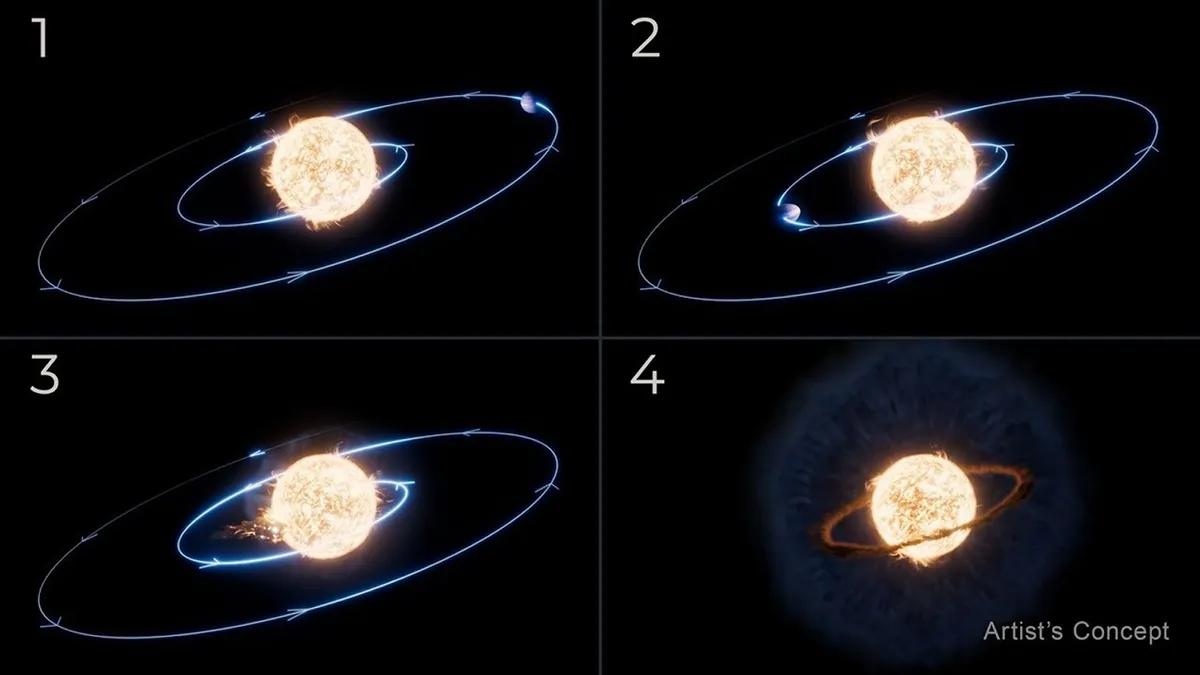
In a groundbreaking discovery, astronomers have shed new light on a celestial event first observed in 2020, where it appeared that a star was engulfing one of its orbiting planets. Recent findings, fueled by data from NASA's James Webb Space Telescope (JWST), now suggest that the event unfolded in a manner quite different from initial beliefs. Instead of the star expanding, it actually drew the planet closer until it was consumed. This revelation marks an important milestone in our understanding of stellar interactions and planetary demise.
The event, designated as ZTF SLRN-2020, involves a star and its Jupiter-sized planet, situated approximately 12,000 light-years away from Earth within the Milky Way galaxy. Researchers observed a bright flash of optical light, signaling that a substantial planet had been engulfed by its host star, leaving behind only a cloud of dust. According to Ryan Lau, the study's first author and an assistant astronomer at the National Science Foundation’s National Optical-Infrared Astronomy Research Laboratory in Tucson, Arizona, this is likely the first instance where a planetary engulfment event has been captured in real time.
Initially, scientists theorized that the star involved in this event was akin to our Sun, undergoing its natural life cycle. A study published in 2023 in the journal Nature described the star as nearing its final stages, entering the red giant phase. During this phase, stars expand significantly as they deplete their hydrogen fuel. The Sun is expected to face a similar fate in about 5 billion years, potentially consuming Mercury, Venus, and possibly Earth in the process.
However, the data collected from JWST presents a divergent narrative. Observations from the telescope’s Mid-Infrared Instrument and Near-Infrared Spectrograph revealed that the star was not emitting the expected infrared light typical of a transitioning red giant. This lack of brightness suggests that the red giant evolution was not occurring as initially thought.
As for the doomed planet, researchers propose that it orbited unusually close to its host star—closer than Mercury’s orbit around the Sun. This close proximity initiated a process known as orbital decay, where the planet gradually spiraled inward due to tidal interactions. These interactions occur when strong gravitational forces between two celestial bodies affect their orbits and dynamics. Lau and his team estimate that this entire sequence took only a few months. Once the planet made contact with the star’s surface, drag forces pulled it into the star’s core, leading to its complete engulfment.
After the planet was consumed, the star expelled some of the planetary material, resulting in the brightening event initially detected in 2020. This ejection included prolonged infrared emissions and dust, further complicating the interpretation of the star's behavior. Researchers initially assumed the star had expanded, but this was not the case.
Events like these can be challenging to detect, as their light signatures are often faint. However, with the impending launch of the Vera C. Rubin Observatory, the detection of such astronomical phenomena is expected to become significantly easier. Lau expressed excitement about the potential for discovering more of these events, emphasizing that advancements in observational technology will likely lead to a greater understanding of the intricate dynamics between stars and their planets.
In conclusion, the revelations from the JWST not only provide clarity on the fate of the planet but also enhance our understanding of stellar evolution and planetary interactions. As research continues, we anticipate more astonishing discoveries in the realm of astronomy.